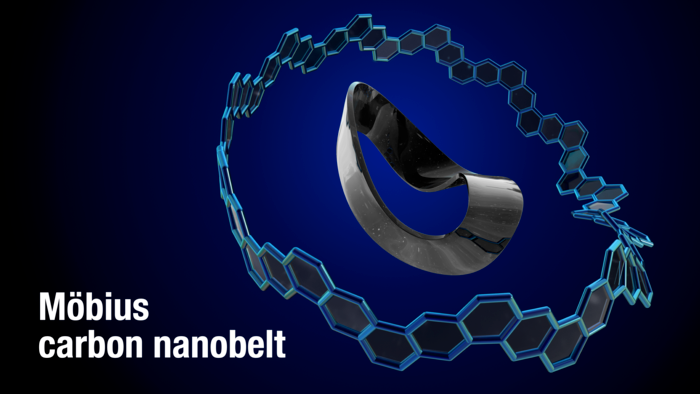To relate structure and function effectively, nanocarbon scientists must first obtain structurally uniform nanocarbons—ideally as single molecules. The creation of functional materials in nanotechnology, optics, electronics, and biomedical applications requires the construction of structurally uniform nanocarbons.
 A new synthesis method creates a belt-shaped molecular nanocarbon with a twisted Möbius band topology, i.e., a Möbius carbon nanobelt. Image Credit: Issey Takahashi.
A new synthesis method creates a belt-shaped molecular nanocarbon with a twisted Möbius band topology, i.e., a Möbius carbon nanobelt. Image Credit: Issey Takahashi.
Molecular nanocarbon science, a bottom-up approach to generating nanocarbons employing synthetic organic chemistry, is an essential tool for achieving this goal. However, the molecular nanocarbons that have been synthesized so far have simple structures such as a ring, bowl, or belt.
It is necessary to develop new methods for synthesizing molecular nanocarbons with more complex structures to realize unexplored and theoretically predicted nanocarbons.
A group of researchers headed by Kenichiro Itami (Professor, Nagoya University), Yasutomo Segawa (Associate Professor, Institute for Molecular Science), and Yuh Hijikata (Specially Appointed Associate Professor, ICReDD) has now synthesized a belt-shaped molecular nanocarbon with a twisted Möbius band topology, i.e., a Möbius carbon nanobelt.
The Möbius carbon nanobelt was a dream molecule in the scientific community after we reported the first chemical synthesis of a carbon nanobelt—an ultra-short carbon nanotube—in 2017. Just like belts we use every day, we imagined what would happen to our ‘molecular belt’ when tightened with a twist. It’s another amazingly beautiful molecule.
Kenichiro Itami, Professor, Nagoya University
The properties and molecular motions of a twisted Möbius carbon nanobelt should be quite distinct from those of a normal belt topology. Generating this twist, however, is easier said than done.
We knew from our previous synthesis of carbon nanobelts that the strain energy is the biggest hurdle in the synthesis. Moreover, the additional twist within the belt structure makes the strain energy of the final target molecule even higher. The key to the success in the actual synthesis was our molecular design and detailed examination of the reaction conditions.
Yasutomo Segawa, Associate Professor, Institute for Molecular Science
Yasutomo Segawa is the co-leader of the project.
The rational synthetic route was discovered through a theoretical analysis of the enormous strain derived from the belt shape and twisted molecular structure of Möbius carbon nanobelt. A newly designed functionalization reaction, Z-selective Wittig reaction sequence, and strain-inducing nickel-mediated homocoupling reaction were used to make the Möbius carbon nanobelt.
The twist moiety of the Möbius band moves fast all around Möbius carbon nanobelt molecule in solution, according to spectroscopic analysis and molecular dynamics simulation. Utilizing chiral separation and circular dichroism spectroscopy, the topological chirality arising from the Möbius structure was experimentally confirmed.
New forms of carbon and nanocarbons have continuously opened doors to new science and technology, resulting in the finding of exceptional (and often unpredictable) properties, functions, and applications throughout history.
The current work is a ground-breaking achievement that lays the groundwork for the development of nanocarbon materials with complex topological structures as well as the emergence of novel materials science based on Möbius topology.
Journal Reference:
Segawa, Y., et al. (2022) Synthesis of a Möbius carbon nanobelt. Nature Synthesis. doi.org/10.1038/s44160-022-00075-8.